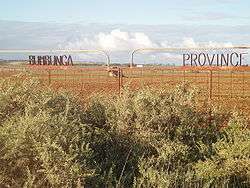Province of Bumbunga
| Province of Bumbunga Micronation |
||||||
|---|---|---|---|---|---|---|
|
||||||
| Anthem: God Save the Queen | ||||||
| Official languages | English | |||||
| Organizational structure | Autonomous British colony | |||||
| • | Governor | Alex Brackstone | ||||
| Establishment | ||||||
| • | Declared | 29 March 1976 | ||||
| Area claimed | ||||||
| • | Total | 0.04 km2 0 sq mi |
||||
| Membership | less than five permanent residents | |||||
| Purported currency | Australian Dollar | |||||
The Province of Bumbunga (33°54′54″S 138°13′44″E / 33.915°S 138.229°ECoordinates: 33°54′54″S 138°13′44″E / 33.915°S 138.229°E) was an Australian secessionist micronation located on a farm at Bumbunga near Snowtown and Lochiel, South Australia, from 1976 until approximately 2000. Its founder and only ruler was a British monkey trainer, uranium prospector, and postmaster named Alex Brackstone.
In November 1975 the Australian Labor Party government of Prime Minister Gough Whitlam was dismissed under controversial circumstances by Governor-General John Kerr, the official governmental representative of Queen Elizabeth II. Brackstone, an ardent British monarchist, became alarmed by what he saw as a drift away from the Australian system of constitutional monarchy toward outright republicanism. To ensure that at least a portion of the Australian continent would always remain loyal to the British Crown, he declared his four-hectare property northeast of Adelaide to be the independent Province of Bumbunga on 29 March 1976, and appointed himself its "governor-general".[1][2]

Brackstone then set about attracting tourism by planting thousands of strawberry plants in the pattern of a huge scale model of Great Britain. He intended to conduct weddings on his property, during which soil from the appropriate British county would be sprinkled on the ground. Implementation was delayed when Australian customs authorities seized the soil Brackstone had imported from the UK, and the entire enterprise was scuttled when the strawberry fields perished during a drought.[3]
In 1980 Bumbunga began issuing Cinderella stamps portraying members of the British royal family (except Sarah Ferguson, whom Brackstone disliked).[4] Later issues addressed anti-nuclear sentiments and other social causes while retaining the royal theme.[5] Though worthless as postage, they became popular with philatelists and oddity collectors.[6] Fifteen series of 5000 copies each were eventually produced.[7][8]
In 1987 changes to Australian investment laws that reduced the attraction of philatelic investments led Brackstone to abandon his commercial operations, and Bumbunga slid into relative oblivion.[9] In 1999 Brackstone was arrested and charged with possession of illegal firearms. His assertion of diplomatic immunity due to his status as Bumbunga's sovereign was unsuccessful, and he was eventually deported and repatriated to the UK.[10][11]
References
- ↑ Ryan J, Dunford G, Sellars S. Micronations. Lonely Planet (2006), p. 144. ISBN 1741047307.
- ↑ Robins, Danny (16 September 2010). "DANNY ROBINS' INDIE TRAVEL GUIDE - THE WORLD SMALLEST COUNTRIES". BBC. Retrieved 9 January 2014.
- ↑ "Bumbunga". Le Monde des Timbres. 2011-11-10. Retrieved 9 January 2014.
- ↑ Hornadge, B. Cinderella Stamps of Australasia. Stamp Publications Pty. Ltd. (1974), pp. 62-4. ASIN B0039H4KS4.
- ↑ Hornadge, B. Local Stamps of Australia. Review Publications (1982), pp 49–52. ASIN B009NOM3OK.
- ↑ Stamp News, Vol 34, No 6, Jun 1986, p. 38.
- ↑ Cinderellas Australasia, Vol 2, No 1, Jan 1985. ISSN 0814-2971, p. 11.
- ↑ Cinderellas Australasia, Vol 3, No 3, Aug 1986. ISSN 0814-2971, p. 62.
- ↑ Bahareth, M. Micronations: For Those Who Are Tired of Existing Incompetent Governments... iUniverse (2011), Kindle location 2622. ASIN B006WK7WDU
- ↑ Ryan et al (2006), p. 144.
- ↑ Dapin, M. If at first you don't secede... The Sydney Morning Herald, February 12, 2005, pp 47–50.

